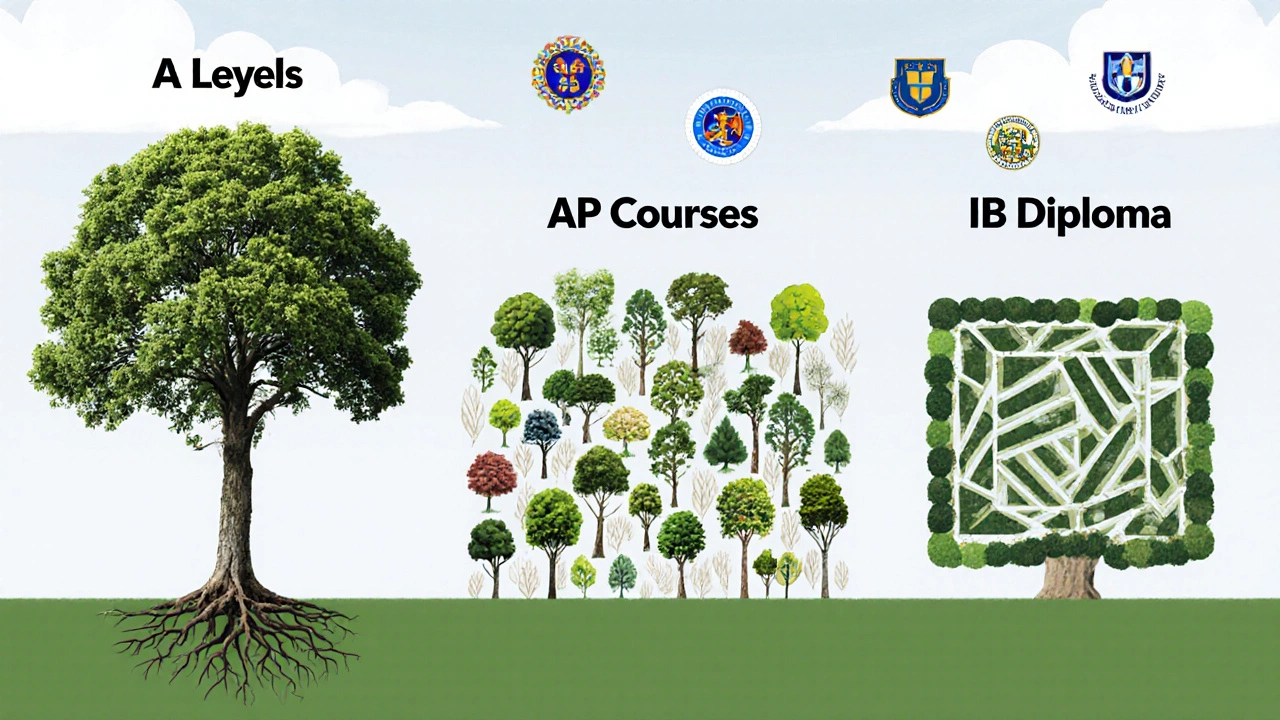A Levels Equivalent Calculator
How Does Your Course Load Compare?
This calculator compares your AP or IB course selection to the A Level system. Input your current high school courses to see how they stack up for college admissions.
Your Course Selection
Key Insights
Your College Readiness Assessment
Subject Coverage
Your program covers 3-4 subjects
A Levels typically focus on 3-4 subjects
Depth of Study
Your courses provide College-level depth
A Levels provide specialized, in-depth study
College Credit Potential
Your courses offer High credit opportunities
Typically 4-5 points needed for credit
Overall Rigor
Your course load is Strong
Top universities value both depth and breadth
Key Recommendation
Taking 3-5 rigorous AP/IB courses in your intended major field aligns well with A Level preparation.
Consider focusing on your strongest subjects to match A Level depth. Most top US colleges prefer students who take 3-5 challenging courses rather than many easier ones.
If you're from the UK or another country that uses A levels, you've probably wondered: A levels are a big deal here-but what’s the American version? The short answer is there isn’t one exact match. The U.S. doesn’t have a single national exam system like A levels. Instead, American students take a mix of courses, standardized tests, and advanced programs that together serve a similar purpose: preparing for college and proving academic readiness.
How A Levels Work in the UK
In the UK, students typically take A levels after completing GCSEs, usually between ages 16 and 18. Most take three to four subjects in depth, focusing intensely on each. These aren’t general surveys of topics-they’re specialized, exam-driven courses. For example, someone aiming for engineering might take A level Maths, Physics, and Further Maths. Grades range from A* to E, and universities base admissions heavily on these results.
A levels are known for their depth. You don’t just learn about biology-you study cell respiration, genetics, and ecology in detail. This focus is what makes them different from most American high school programs.
The American System: Broader, But With Advanced Options
In the U.S., students take a mix of required and elective courses across subjects like English, math, science, history, and electives like art or computer science. Unlike A levels, American high schools don’t let students drop most subjects early. Most students take eight to ten subjects each year until graduation at age 17 or 18.
But there’s a catch: the U.S. doesn’t have one standardized final exam for college entry. Instead, colleges look at your GPA, the rigor of your courses, SAT or ACT scores, extracurriculars, and sometimes essays. That’s why advanced programs like AP and IB exist-they add the depth that regular high school classes lack.
AP Courses: The Closest Thing to A Levels
Advanced Placement (AP) courses are the most direct parallel to A levels. Offered by the College Board, AP classes are college-level courses taught in high school. Students take exams at the end of the year, and scores from 1 to 5 determine if they earn college credit. A score of 4 or 5 often means you can skip intro classes in college.
There are over 30 AP subjects-from Calculus BC to Art History to Environmental Science. Students typically take 3 to 5 AP courses over their junior and senior years. That’s similar to how many UK students take 3 to 4 A levels. And like A levels, AP courses are rigorous. For example, AP Chemistry dives into thermodynamics and molecular geometry, not just basic reactions.
But here’s the difference: AP courses are still part of a broader high school schedule. You might take AP Biology, then English 12, then U.S. History, then band-all in the same day. A level students usually spend most of their time on just three or four subjects.

IB Diploma: The Other Strong Alternative
The International Baccalaureate (IB) Diploma Program is another option, especially in international schools or private U.S. schools. It’s more structured than AP. Students take six subjects-three at higher level (HL) and three at standard level (SL)-plus a theory of knowledge course, an extended essay, and creativity/service hours.
IB HL courses are often considered even closer to A levels than AP. For example, IB HL Maths covers calculus, statistics, and complex numbers at a level comparable to A level Further Maths. The IB also requires students to write a 4,000-word research paper, similar to the coursework component in some A level subjects.
But IB is harder to access. Only about 1,800 U.S. public schools offer it, compared to over 20,000 that offer AP. So while IB is a strong match, it’s not as widely available.
What About the SAT and ACT?
The SAT and ACT are standardized tests, not curriculum systems. They measure general skills in math, reading, and writing. You can think of them as a snapshot-not a deep dive.
A levels and AP/IB are about sustained study over two years. The SAT is a three-hour test. Colleges look at both: your grades in tough classes (like AP Biology) show you can handle college-level work. Your SAT score shows you can handle standardized testing. Neither alone tells the full story.
That’s why top U.S. colleges care more about your course load than your SAT score. Taking four APs and getting B’s looks better than taking two APs and getting A’s.
Comparing A Levels, AP, and IB Side by Side
| Feature | A Levels (UK) | AP (USA) | IB Diploma (Global) |
|---|---|---|---|
| Number of subjects | 3-4 focused subjects | 3-5 chosen subjects | 6 subjects (3 HL, 3 SL) |
| Depth of study | Very deep-specialized | College-level depth | Very deep (HL), moderate (SL) |
| Final assessment | End-of-course exams | End-of-course AP exam | Final exams + extended essay + TOK |
| College credit | Yes, based on grade | Yes, based on AP score (4-5) | Yes, based on HL scores and total points |
| Flexibility | High-drop subjects after GCSE | High-choose what to take | Low-structured program |
| Availability in U.S. | Some international/private schools | Over 20,000 schools | ~1,800 schools |

Why This Matters for Students and Parents
If you’re a UK student applying to U.S. colleges, admissions officers know what A levels are. They don’t need you to explain them. They’ll look at your subject choices and grades just like they would for AP or IB. A* in A level Physics? That’s impressive. They’ll treat it like a 5 on AP Physics.
If you’re an American student wondering how to match the rigor of A levels, focus on taking the hardest courses your school offers. Take AP or IB. Don’t just chase high grades-chase challenge. Colleges want to see you pushing yourself.
If you’re moving from the U.S. to the UK, you might find A levels overwhelming because you’re expected to drop subjects early. But you’ll also find that the depth of study lets you master topics you care about.
What Do Colleges Really Look For?
Top universities-whether in the U.S., UK, Canada, or Australia-don’t care what you call your program. They care if you’ve challenged yourself. They want to see:
- Subjects that align with your intended major
- High grades in rigorous courses
- Consistency over time
- Evidence you can handle college-level work
So whether you’re taking A levels in London, AP in Chicago, or IB in Tokyo, what matters is how much you’ve grown-not the name on your transcript.
Bottom Line: No Direct Equivalent, But Plenty of Options
A levels don’t have a direct twin in the U.S. But AP courses come closest in depth and college recognition. IB offers a broader, more holistic alternative. The American system trades specialization for breadth-but smart students fill the gap by choosing the toughest courses available.
If you’re comparing systems, don’t look for a 1:1 match. Look for the same outcome: a student who’s prepared, focused, and ready for university-level work. That’s what colleges everywhere are looking for.
Are A levels harder than AP courses?
It depends on the subject and the student. A levels require deeper focus on fewer subjects, while AP courses are part of a broader schedule. Many students find A levels more intense because they spend most of their time on just three or four subjects. AP exams are challenging too, but students usually balance them with other classes. Both are respected by top universities.
Can I use A levels to get into U.S. colleges?
Yes, absolutely. U.S. colleges are very familiar with A levels. Many top schools, including Harvard, Stanford, and MIT, actively recruit international students with A levels. They often grant college credit for high scores (A or A*), similar to how they treat AP scores of 4 or 5. Your subject choices matter too-A levels in STEM subjects are especially valued for engineering or science programs.
Do American students take A levels?
Rarely. A levels are offered in only a few international or private schools in the U.S., mostly in cities like New York, Los Angeles, or Boston. Most American students take AP or IB instead. If a U.S. student takes A levels, it’s usually because they’re enrolled in a British curriculum school or are an expat.
Is IB better than A levels?
Neither is universally better-it depends on your goals. IB gives you a well-rounded education with critical thinking and research skills built in. A levels let you specialize deeply in your strongest areas. If you’re sure about your university major early on, A levels might suit you better. If you want a broader foundation, IB is stronger. Both are equally respected by top universities worldwide.
What’s the U.S. equivalent of an A* in A levels?
There’s no direct grade conversion, but an A* in A levels is generally seen as equivalent to a 5 on an AP exam or an A+ in an IB Higher Level course. U.S. colleges recognize these as top-tier performance. What matters most is the rigor of the subject-getting an A* in A level Maths or Physics carries more weight than an A* in a less demanding subject.


Write a comment